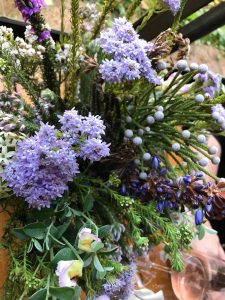
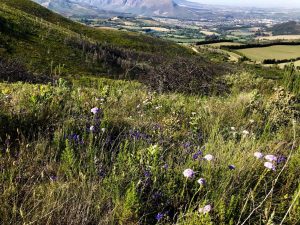
Delheim Wine Estate lies across a 2 km stretch of Simonsberg. In the 1970’s, land not under vineyard cultivation was heavily planted with what would become the largest private pine plantation in the Western Cape. 150 hectares of the pine plantation were destroyed by fire in 2000. The pine forests were replanted, only to burn down again completely in 2016. The owners realised that pine plantations were just not feasible, and decided to let the indigenous fynbos regrow without any interference.
The results have been astonishing. The fires caused germination of dormant seeds in the soil and to date, 120 different species have been identified – an incredible diversity of plants in such a small area. Fortunately, the pines have had a fairly limited impact on the soil’s pH levels, unlike the bluegum and black wattle trees planted elsewhere on neighbouring estates, where fynbos regrowth is much slower due to the high level of soil acidity.
I found this fascinating article on fynbos and fire on the Fynbos Hub website:
“Fynbos is a fire-adapted vegetation that requires regular burning for its persistence. In the absence of fire, fynbos is gradually replaced by thicket species. It thrives on infertile soils and fire is the mechanism that recycles precious nutrients from old moribund growth into the soil. Fire in fynbos is far from a disaster, but rather a crucial trigger that resets the fynbos ‘succesional clock’. It provides the stimulus for dormant seeds to germinate and the opportunity for many annuals, short-lived perennials and bulbs to grow, flower and seed during times of abundant nutrients and sunlight. They complete their short life cycles, returning to the soil as the larger shrubs overwhelm them, and remain dormant until the next fire. The optimal fire cycle for fynbos is between 10-14 years. Shorter fire cycles can wipe out slow maturing species, while species start dying when intervals become too long.
Fires are more common in fynbos than in any other heathlands in the world and it’s rare to find fynbos stands of more than 20 years of age. Some species re-establish by sprouting from a woody root-stock (these plants are known as resprouters); while others germinate from seed that has been stored in the soil or on plant canopies between fires (reseeders). Some resprouters, including many of the larger Proteaceae, protect their trunks from fire with a thick, insulating layer of corky bark and resprout from buds buried in the trunk following fire. Unlike sprouters, the seeders have a complete turnover in generations after each fire and are therefore subjected to a greater frequency of natural selection and higher speciation. The high diversity of species in fynbos can, at least in part, be ascribed to population fragmentation and regular turnover in generations as a result of fire.
The huge 2006 fire that swept across the Agulhas Plain was frightening to witness, yet the subsequent regrowth and succession of fynbos over the last five years has been a wonder to behold. Part of this blog will revisit the amazing impact of this 60 000 hectare blaze on the flora and fauna of the region in the Fire Diary – a week by week record of the remarkable recovery of the Walker Bay fynbos since 2006.”
For more info, visit www.fynboshub.co.za
At Delheim the lower slopes of Simonsberg are covered in Renosterveld fynbos, that gradually changes into granite mountain fynbos towards the upper reaches of the mountain. In look and type, the fynbos species found in these two areas are completely different.
I recently had the most delightful experience with owner Nora Sperling Thiel, who took me on a leisurely fynbos walk up the mountain. Nora says her passion for fynbos has grown steadily over the years, largely through reading, walking and studying the land firsthand, and also by consulting with fynbos expert John Manning, author of the excellent Field Guide to Fynbos. Nora and John have done many walks in the Delheim fynbos to study and identify different plants.
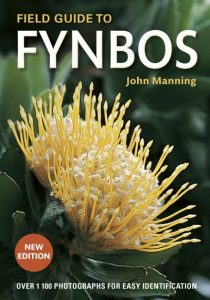
Nora is intensely aware of, and grateful for the privilege of living on such a beautiful piece of land, with its abundant riches in fauna and flora. To celebrate aspects of this, Delheim offers a unique Fynbos Cupcakes and Wine Experience in the Tasting Room, at only R120 pp. Click here to read more about Delheim Fynbos Cupcakes and Wine Experience Promotes Biodiversity.
Below are photos of the more than 22 different types of fynbos I picked at Delheim during my walk with Nora Sperling Thiel:
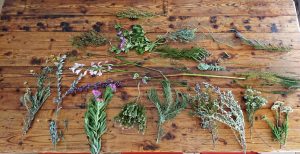
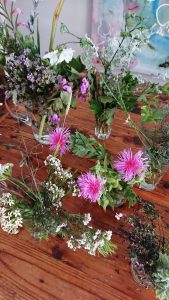
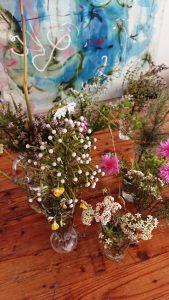
FASCINATING FYNBOS FACTS:
The natural character of the pairing components – the fynbos-inspired cupcakes and wines – is the thin edge of the wedge of environmental thoughtfulness that has been part of Delheim recipe for decades. The farm’s first environmental management plan was written in 1976.
In the context of especially fynbos conservation, contributions by Delheim and farms like it have been invaluable. Fynbos is a sub-set of the Cape Floral Kingdom, the smallest of the six Floral Kingdoms in the world, and the only one entirely contained within a single country.
According to the SA National Biodiversity Institute, over one third of all plant species in the country occur in the Cape Floral Kingdom. The organisation adds however that “distressingly, some three-quarters of all plants in the South African Red Data Book occur in the Cape Floral Kingdom: 1 700 plant species are threatened to some extent with extinction”.
As a WWF-SA Conservation Champion, Delheim is acknowledged as an industry leader for its commitment to conservation, responsible production practices, integrated environmental management systems. It is also a founder member of the Greater Simonsberg Conservancy under Cape Nature’s stewardship programme, actively participating in protection and conservation.
Among its initiatives, Delheim uses a bio-natural water management plant that recycles all cellar waste water on the farm; takes care to preserve substantial tracts of mountain fynbos and promote a bio-diversity; and, encourages parasitic insects to control pests in the vineyards.
The result has led to Delheim being home to 120 different species of indigenous plants and animals.
Among Delheim’s other environmental highlights, an assortment of carefully developed dams, ponds and waterways have promoted a rich diversity of bird-life. There is a pair of breeding Blue Cranes on the farm while African Fish Eagles are regular visitors. On the Klapmutskop, which forms part of Delheim’s Vera Cruz property, a 300-year old yellowwood was discovered and is recorded as the oldest tree in an indigenous yellowwood forest in the country. Another protected plant, the Silver Tree, occurs naturally at Delheim and Delheim data shows the recovery of its endangered Renosterveld – another endangered component of the Cape Floral Kingdom.
The Delheim Wine & Fynbos Cupcake Pairing is available at R120 per person. Bookings are preferred while the experience for walk-in visitors is subject to availability. Reservation is essential for groups larger than nine people. To book, email cellardoor@delheim.com.
For more information, visit www.delheim.com or contact Delheim on info@delheim.com or 021 888 4600. Also find Delheim on Facebook, Twitter @Delheim and Instagram @delheimwines.
Delheim Estate is in the Simonsberg sub-region of the Stellenbosch Wine Routes, on the Knorhoek Road, off the R44.